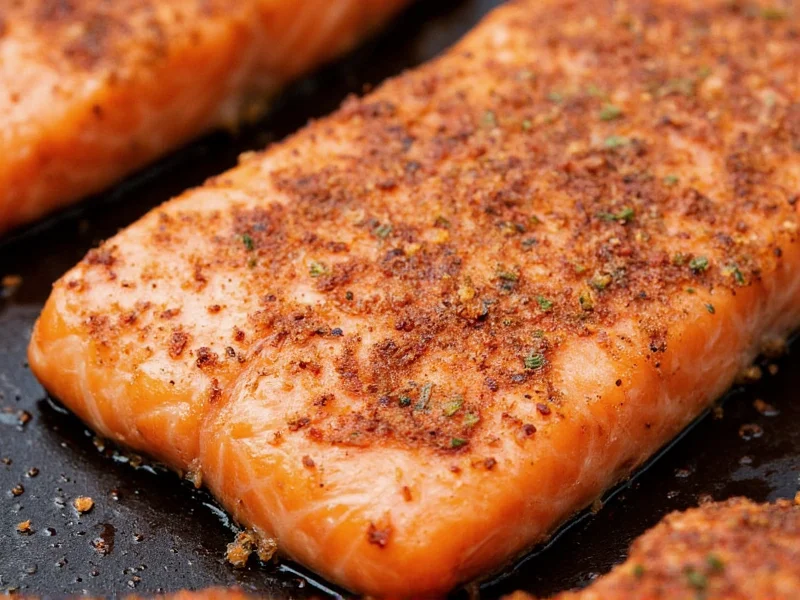The Science Behind the Perfect Salmon Dry Rub
Creating an exceptional dry rub for grilled salmon requires understanding how ingredients interact with fish proteins. Salmon's delicate texture and rich omega-3 content respond best to balanced seasoning that complements rather than overwhelms. Unlike red meat, fish requires less salt in dry rubs to prevent moisture loss during the high-heat grilling process. The ideal dry rub for grilled salmon contains a harmonious blend of aromatic spices that form a flavorful crust while protecting the fish's natural moisture.
Essential Dry Rub Components Explained
Each ingredient in your homemade salmon seasoning recipe serves a specific purpose in developing flavor and texture:
| Ingredient | Function | Recommended Amount |
|---|---|---|
| Smoked Paprika | Provides depth and subtle smokiness that complements grilling | 2 tablespoons |
| Garlic Powder | Even flavor distribution without burning | 1 tablespoon |
| Onion Powder | Enhances umami without raw onion texture | 1 tablespoon |
| Kosher Salt | Seasons without over-salting delicate fish | 1 teaspoon |
| Dried Thyme | Adds herbal complexity that pairs with salmon | 1 teaspoon |
| Cayenne Pepper | Provides subtle heat without overpowering | 1/2 teaspoon |
Step-by-Step Dry Rub Preparation Guide
Follow these precise steps for the perfect grilled salmon seasoning blend:
- Mix dry ingredients thoroughly in a small bowl, ensuring even distribution of all components. Whisking prevents clumping of spices like garlic powder.
- Pat salmon fillets completely dry with paper towels before applying the rub. Moisture prevents proper crust formation.
- Apply seasoning generously but evenly, using approximately 1 tablespoon of rub per 6-ounce fillet. Press gently to adhere.
- Rest before grilling for 15-30 minutes at room temperature. This crucial step allows flavors to penetrate without drawing out moisture.
- Grill over medium-high heat (375-400°F) for 4-6 minutes per side, depending on thickness. The dry rub creates a flavorful crust while protecting the delicate flesh.
Advanced Grilling Techniques for Perfect Results
Professional chefs recommend these techniques when using a dry rub for grilled salmon:
- Two-zone grilling: Create a hot zone for searing and a cooler zone for finishing. Start skin-side down on the hot zone to crisp the skin, then move to the cooler zone to finish cooking.
- Oil the fish, not the grill: Lightly brush the salmon with neutral oil rather than oiling the grates, which prevents the dry rub from washing off.
- Don't flip too soon: Allow the salmon to develop a proper crust before turning—typically 70-80% of the cooking time on the first side.
- Internal temperature check: Remove salmon at 125°F for medium-rare (it will continue cooking to 130-135°F), the ideal range for moist, flaky texture.
Common Dry Rub Mistakes to Avoid
Many home cooks make these errors when preparing salmon with dry rub:
- Applying rub too early: More than 30 minutes before cooking can draw out moisture through osmosis, resulting in less tender fish.
- Using fresh garlic or onion: These burn quickly on the grill, creating bitter flavors. Powdered forms distribute evenly without burning.
- Over-salting: Fish requires less salt than meat. Stick to 1 teaspoon per pound of salmon in your dry rub mixture.
- Pressing too hard: While you should press the rub to adhere, excessive pressure damages the delicate flesh.
- Grilling over direct high heat: This burns the spices before the salmon cooks through. Medium-high heat creates the perfect crust without charring.
Variations for Different Flavor Profiles
Customize your dry rub for grilled salmon based on your flavor preferences:
Mediterranean Style
Replace thyme with equal parts dried oregano and rosemary. Add 1 teaspoon lemon zest to the dry rub mixture for bright citrus notes that complement salmon beautifully.
Southwest Inspired
Increase cayenne to 1 teaspoon and add 1 teaspoon ground cumin. This bold dry rub for grilled salmon pairs perfectly with avocado salsa and lime wedges.
Sugar-Free Option
Many commercial rubs contain sugar, which burns easily on fish. This healthy salmon seasoning without sugar uses smoked paprika for natural sweetness and depth.
Timing and Storage Recommendations
For optimal results with your homemade salmon seasoning recipe:
- Application timing: Apply dry rub 15-30 minutes before grilling. Longer periods can dry out the surface.
- Storage: Keep unused dry rub in an airtight container away from light for up to 3 months. Exposure to air degrades spice potency.
- Batch preparation: Make larger quantities of your favorite dry rub proportions for salmon and store in labeled jars for quick weeknight meals.
- Leftover rub: Use excess dry rub on roasted vegetables, chicken, or in salad dressings to avoid waste.
Why This Dry Rub Method Works Best
The specific proportions in this dry rub for grilled salmon create a flavor balance that enhances rather than masks the fish's natural taste. The combination of smoked paprika and dried herbs forms a protective layer that minimizes moisture loss during grilling while developing complex flavor compounds through the Maillard reaction. Unlike wet marinades that can make the surface too moist for proper searing, a well-formulated dry rub creates the ideal texture contrast between the flavorful crust and tender interior that defines perfectly grilled salmon.











 浙公网安备
33010002000092号
浙公网安备
33010002000092号 浙B2-20120091-4
浙B2-20120091-4